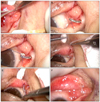Abstract
Purpose
To assess the surgical results of a punctoplasty with insertion of a silicone tube using a pigtail probe for the management of acquired punctal obstruction.
Methods
The medical records of 61 patients who underwent an operation for the management of punctual obstruction were reviewed. After punctal dilation, fluorescein dye disappearance test was performed to evaluate its efficacy. In the case of no functional delay after punctal dilation, three-snip punctoplasty with a silicone tube using a pigtail probe was performed. In the case of a functional delay, three-snip punctoplasty with a silicone tube into the nasolacrimal duct was performed.
Results
The surgical success over 1 year was 39.1% in patients who underwent only three-snip punctoplasty, 79.2% in patients who underwent a three-snip punctoplasty with a silicone tube insertion into the nasolacrimal duct, and 85.7% in patients who underwent a three-snip punctoplasty with canalicular intubation using a pigtail probe.
Figures and Tables
Figure 1
(A) A vertical snip incision is made on the medial aspect of the posterior rim of the puctum. (B) Pigtail probe is passed along the canaliculus and exits at the opposite puctum. (C) 6-0 prolene stitch is threaded onto the probe which is then reversed leaving a 6-0 prolene stitch in the system. (D) Silicone tube is threaded over a 6-0 prolene stitch. (E) The 6-0 prolene suture is tied and the silicone tubing is rotated so the knot site is at the level of the common canaliculus. (F) Silicone tubing with a 6-0 prolene stitches inside it in the medial canthus.

References
1. Jones LT. The cure of epiphora due to canalicular disorders, trauma and surgical failures on the lacrimal passages. Trans Am Acad Ophthalmol Otolaryngol. 1962. 66:506–524.
2. Kwak JY, Chang HK. Silicone intubation for treatment of punctal stenosis. J Korean Ophthalmol Soc. 2003. 44:2451–2456.
3. Jeong S. A simple test for epiphora caused by punctal stenosis. J Korean Ophthalmol Soc. 1998. 39:2864–2866.
4. Fein W. Cautery applications to relieve punctal stenosis. Arch Ophthalmol. 1977. 95:145–146.
5. Veirs ER. Lacrimal Disoders: Diagnosis and Treatment. 1976. St. Louis: CV Mosby;68–71.
6. Carter KD, Nelson CC, Martonyi CL. Size variation of the lacrimal punctum in adults. Ophthal Plast Reconstr Surg. 1988. 4:231–233.
7. Yoon KC, Jeong SK, Park YG. Study of lacrimal punctal size in normal adults. J Korean Ophthalmol Soc. 1997. 38:1916–1920.
8. Coster DJ, Welham RA. Herpetic canalicular obstruction. Br J Ophthalmol. 1979. 63:259–262.
9. Lamping K, Levine MR. Jones' tubes. How good are they? Arch Ophthalmol. 1983. 101:260–261.
10. Bowman W. Methode de traitment applicable a l'epiphora dependent du renversement en dehors ou de l'obliteration des points lacrymaux. Ann Oculist. 1853. 29:52–55.
11. Graves B. Making a new lacrimal punctum. Am J Ophthalmol. 1926. 9:675–677.
12. Veir ER. Veir ER, editor. Disorders of the canaliculus. The Lacrimal System, Clinical Application. 1955. New York: Grune & Stratton;46–47.
13. Hughes WL, Maris CS. A clip procedure for stenosis and eversion of the lacrimal punctum. Trans Am Acad Ophthalmol Otolaryngol. 1967. 71:653–655.
14. Awan KJ. Laser punctoplasty for the treatment of punctal stenosis. Am J Ophthalmol. 1985. 100:341–342.
15. Kim EK, Kim HB, Kim TH. Acquired punctal stenosis treated by laser punctoplasty. J Korean Ophthalmol Soc. 1988. 29:401–405.
16. Koh HG, La TY. Punctoplasty using cut down tube. J Korean Ophthalmol Soc. 2004. 45:546–551.
17. Konuk O, Urgancioglu B, Unal M. Long-term success rate of perforated punctal plugs in the management of acquired punctal stenosis. Ophthal Plast Reconstr Surg. 2008. 24:399–402.
18. Kashkouli MB, Beigi B, Astbury N. Acquired external punctal stenosis: surgical management and long-term follow-up. Orbit. 2005. 24:73–78.
19. Park HJ, Hwang WS. Clinical results of silicone intubation for epiphora patients. J Korean Ophthalmol Soc. 2000. 41:2327–2331.
20. Choi CU, Seo SW, Kim SD. The comparison of punctoplasty and silicone tube intubation in patients with punctal obstruction. J Korean Ophthalmol Soc. 2008. 49:543–547.
21. Anderson RL, Edwards JJ. Indications, complications and results with silicone stents. Ophthalmology. 1979. 86:1474–1487.
22. Kwon YH, Lee YJ. Long-term results of silicone tube intubation in incomplete nasolacrimal duct obstruction (NLDO). J Korean Ophthalmol Soc. 2008. 49:190–194.
23. Saunders DH, Shannon GM, Flanagan JC. The effectiveness of the pigtail probe method of repairing canalicular lacerations. Ophthalmic Surg. 1978. 9:33–40.
24. Jordan DR, Nerad JA, Tse DT. The pigtail probe, revisited. Ophthalmology. 1990. 97:512–519.
25. Jordan DR, Gilberg S, Mawn LA. The round-tipped, eyed pigtail probe for canalicular intubation: a review of 228 patients. Ophthal Plast Reconstr Surg. 2008. 24:176–180.
26. Dale DL. Stephenson CM, editor. Embryology, anatomy and physiology of the lacrimal drainage system. Ophthalmic Plastic, Reconstructive, and Orbital Surgery. 1997. Boston, Mass: Butterworth-Heinemann;19–30.
27. Yazici B, Yazici Z. Frequency of the common canaliculus: a radiological study. Arch Ophthalmol. 2000. 118:1381–1385.




 PDF
PDF ePub
ePub Citation
Citation Print
Print




 XML Download
XML Download